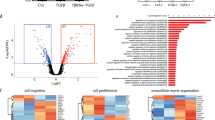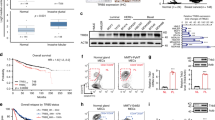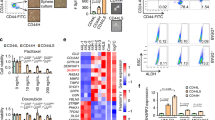Abstract
Kruppel-like factor 4 (KLF4) is highly expressed in more than 70% of breast cancers and functions as an oncogene. However, an exact mechanism by which KLF4 enhances tumorigenesis of breast cancer remains unknown. In this study, we show that KLF4 was highly expressed in cancer stem cell (CSC)-enriched populations in mouse primary mammary tumor and breast cancer cell lines. Knockdown of KLF4 in breast cancer cells (MCF-7 and MDA-MB-231) decreased the proportion of stem/progenitor cells as demonstrated by expression of stem cell surface markers such as aldehyde dehydrogenase 1, side population and by in vitro mammosphere assay. Consistently KLF4 overexpression led to an increase of the cancer stem cell population. KLF4 knockdown also suppressed cell migration and invasion in MCF-7 and MDA-MB-231 cells. Furthermore, knockdown of KLF4 reduced colony formation in vitro and inhibited tumorigenesis in immunocompromised non-obese diabetic/severe combined immunodeficiency mice, supporting an oncogenic role for KLF4 in breast cancer development. Further mechanistic studies revealed that the Notch signaling pathway was required for KLF4-mediated cell migration and invasion, but not for CSC maintenance. Taken together, our study provides evidence that KLF4 has a potent oncogenic role in mammary tumorigenesis likely by maintaining stem cell–like features and by promoting cell migration and invasion. Thus, targeting KLF4 may provide an effective therapeutic approach to suppress tumorigenicity in breast cancer.
This is a preview of subscription content, access via your institution
Access options
Subscribe to this journal
Receive 50 print issues and online access
$259.00 per year
only $5.18 per issue
Buy this article
- Purchase on Springer Link
- Instant access to full article PDF
Prices may be subject to local taxes which are calculated during checkout






Similar content being viewed by others
References
Al-Hajj M, Wicha MS, Benito-Hernandez A, Morrison SJ, Clarke MF . (2003). Prospective identification of tumorigenic breast cancer cells. Proc Natl Acad Sci USA 100: 3983–3988.
Bonnet D, Dick JE . (1997). Human acute myeloid leukemia is organized as a hierarchy that originates from a primitive hematopoietic cell. Nat Med 3: 730–737.
Bruce SJ, Gardiner BB, Burke LJ, Gongora MM, Grimmond SM, Perkins AC . (2007). Dynamic transcription programs during ES cell differentiation towards mesoderm in serum versus serum-freeBMP4 culture. BMC Genomics 8: 365.
Charafe-Jauffret E, Monville F, Ginestier C, Dontu G, Birnbaum D, Wicha MS . (2008). Cancer stem cells in breast: current opinion and future challenges. Pathobiology 75: 75–84.
Choi BJ, Cho YG, Song JW, Kim CJ, Kim SY, Nam SW et al. (2006). Altered expression of the KLF4 in colorectal cancers. Pathol Res Pract 202: 585–589.
Dang DT, Chen X, Feng J, Torbenson M, Dang LH, Yang VW . (2003). Overexpression of Kruppel-like factor 4 in the human colon cancer cell line RKO leads to reduced tumorigenecity. Oncogene 22: 3424–3430.
Dontu G, Jackson KW, McNicholas E, Kawamura MJ, Abdallah WM, Wicha MS . (2004). Role of Notch signaling in cell-fate determination of human mammary stem/progenitor cells. Breast Cancer Res 6: R605–R615.
Eaton SA, Funnell AP, Sue N, Nicholas H, Pearson RC, Crossley M . (2008). A network of Kruppel-like factors (Klfs). Klf8 is repressed by Klf3 and activated by Klf1 in vivo. J Biol Chem 283: 26937–26947.
Faherty S, Fitzgerald A, Keohan M, Quinlan LR . (2007). Self-renewal and differentiation of mouse embryonic stem cells as measured by Oct4 expression: the role of the cAMP/PKA pathway. In vitro Cell Dev Biol Anim 43: 37–47.
Farnie G, Clarke RB . (2007). Mammary stem cells and breast cancer—role of Notch signalling. Stem Cell Rev 3: 169–175.
Fillmore CM, Kuperwasser C . (2008). Human breast cancer cell lines contain stem-like cells that self-renew, give rise to phenotypically diverse progeny and survive chemotherapy. Breast Cancer Res 10: R25.
Foster KW, Frost AR, McKie-Bell P, Lin CY, Engler JA, Grizzle WE et al. (2000). Increase of GKLF messenger RNA and protein expression during progression of breast cancer. Cancer Res 60: 6488–6495.
Foster KW, Liu Z, Nail CD, Li X, Fitzgerald TJ, Bailey SK et al. (2005). Induction of KLF4 in basal keratinocytes blocks the proliferation-differentiation switch and initiates squamous epithelial dysplasia. Oncogene 24: 1491–1500.
Garvey SM, Sinden DS, Schoppee Bortz PD, Wamhoff BR . (2010). Cyclosporine up-regulates Kruppel-like factor-4 (KLF4) in vascular smooth muscle cells and drives phenotypic modulation in vivo. J Pharmacol Exp Ther 333: 34–42.
Ghaleb AM, Aggarwal G, Bialkowska AB, Nandan MO, Yang VW . (2008). Notch inhibits expression of the Kruppel-like factor 4 tumor suppressor in the intestinal epithelium. Mol Cancer Res 6: 1920–1927.
Ginestier C, Hur MH, Charafe-Jauffret E, Monville F, Dutcher J, Brown M et al. (2007). ALDH1 is a marker of normal and malignant human mammary stem cells and a predictor of poor clinical outcome. Cell Stem Cell 1: 555–567.
Gudjonsson T, Villadsen R, Nielsen HL, Ronnov-Jessen L, Bissell MJ, Petersen OW . (2002). Isolation, immortalization, and characterization of a human breast epithelial cell line with stem cell properties. Genes Dev 16: 693–706.
Hinnebusch BF, Siddique A, Henderson JW, Malo MS, Zhang W, Athaide CP et al. (2004). Enterocyte differentiation marker intestinal alkaline phosphatase is a target gene of the gut-enriched Kruppel-like factor. Am J Physiol Gastrointest Liver Physiol 286: G23–G30.
Hirschmann-Jax C, Foster AE, Wulf GG, Nuchtern JG, Jax TW, Gobel U et al. (2004). A distinct ‘side population’ of cells with high drug efflux capacity in human tumor cells. Proc Natl Acad Sci USA 101: 14228–14233.
Huang CC, Liu Z, Li X, Bailey SK, Nail CD, Foster KW et al. (2005). KLF4 and PCNA identify stages of tumor initiation in a conditional model of cutaneous squamous epithelial neoplasia. Cancer Biol Ther 4: 1401–1408.
Hwang-Verslues WW, Kuo WH, Chang PH, Pan CC, Wang HH, Tsai ST et al. (2009). Multiple lineages of human breast cancer stem/progenitor cells identified by profiling with stem cell markers. PLoS One 4: e8377.
Kelly PN, Dakic A, Adams JM, Nutt SL, Strasser A . (2007). Tumor growth need not be driven by rare cancer stem cells. Science 317: 337.
King KE, Iyemere VP, Weissberg PL, Shanahan CM . (2003). Kruppel-like factor 4 (KLF4/GKLF) is a target of bone morphogenetic proteins and transforming growth factor beta 1 in the regulation of vascular smooth muscle cell phenotype. J Biol Chem 278: 11661–11669.
Lambertini C, Pantano S, Dotto GP . (2010). Differential control of Notch1 gene transcription by Klf4 and Sp3 transcription factors in normal versus cancer-derived keratinocytes. PLoS One 5: e10369.
Lawson JC, Blatch GL, Edkins AL . (2009). Cancer stem cells in breast cancer and metastasis. Breast Cancer Res Treat 118: 241–254.
Li Y, McClintick J, Zhong L, Edenberg HJ, Yoder MC, Chan RJ . (2005). Murine embryonic stem cell differentiation is promoted by SOCS-3 and inhibited by the zinc finger transcription factor Klf4. Blood 105: 635–637.
Liu Z, Teng L, Bailey SK, Frost AR, Bland KI, LoBuglio AF et al. (2009). Epithelial transformation by KLF4 requires Notch1 but not canonical Notch1 signaling. Cancer Biol Ther 8: 1840–1851.
Lyssiotis CA, Foreman RK, Staerk J, Garcia M, Mathur D, Markoulaki S et al. (2009). Reprogramming of murine fibroblasts to induced pluripotent stem cells with chemical complementation of Klf4. Proc Natl Acad Sci USA 106: 8912–8917.
Mani SA, Guo W, Liao MJ, Eaton EN, Ayyanan A, Zhou AY et al. (2008). The epithelial-mesenchymal transition generates cells with properties of stem cells. Cell 133: 704–715.
Miettinen PJ, Ebner R, Lopez AR, Derynck R . (1994). TGF-beta induced transdifferentiation of mammary epithelial cells to mesenchymal cells: involvement of type I receptors. J Cell Biol 127: 2021–2036.
Miller KA, Eklund EA, Peddinghaus ML, Cao Z, Fernandes N, Turk PW et al. (2001). Kruppel-like factor 4 regulates laminin alpha 3A expression in mammary epithelial cells. J Biol Chem 276: 42863–42868.
O'Brien CA, Kreso A, Jamieson CH . (2010). Cancer stem cells and self-renewal. Clin Cancer Res 16: 3113–3120.
O'Brien CA, Pollett A, Gallinger S, Dick JE . (2007). A human colon cancer cell capable of initiating tumour growth in immunodeficient mice. Nature 445: 106–110.
Pandya AY, Talley LI, Frost AR, Fitzgerald TJ, Trivedi V, Chakravarthy M et al. (2004). Nuclear localization of KLF4 is associated with an aggressive phenotype in early-stage breast cancer. Clin Cancer Res 10: 2709–2719.
Real PJ, Tosello V, Palomero T, Castillo M, Hernando E, de Stanchina E et al. (2009). Gamma-secretase inhibitors reverse glucocorticoid resistance in T cell acute lymphoblastic leukemia. Nat Med 15: 50–58.
Rowland BD, Bernards R, Peeper DS . (2005). The KLF4 tumour suppressor is a transcriptional repressor of p53 that acts as a context-dependent oncogene. Nat Cell Biol 7: 1074–1082.
Sahlgren C, Gustafsson MV, Jin S, Poellinger L, Lendahl U . (2008). Notch signaling mediates hypoxia-induced tumor cell migration and invasion. Proc Natl Acad Sci USA 105: 6392–6397.
Segre JA, Bauer C, Fuchs E . (1999). Klf4 is a transcription factor required for establishing the barrier function of the skin. Nat Genet 22: 356–360.
Shackleton M, Vaillant F, Simpson KJ, Stingl J, Smyth GK, Asselin-Labat ML et al. (2006). Generation of a functional mammary gland from a single stem cell. Nature 439: 84–88.
Shie JL, Chen ZY, Fu M, Pestell RG, Tseng CC . (2000). Gut-enriched Kruppel-like factor represses cyclin D1 promoter activity through Sp1 motif. Nucleic Acids Res 28: 2969–2976.
Shields JM, Christy RJ, Yang VW . (1996). Identification and characterization of a gene encoding a gut-enriched Kruppel-like factor expressed during growth arrest. J Biol Chem 271: 20009–20017.
Singh SK, Hawkins C, Clarke ID, Squire JA, Bayani J, Hide T et al. (2004). Identification of human brain tumour initiating cells. Nature 432: 396–401.
Takahashi K, Yamanaka S . (2006). Induction of pluripotent stem cells from mouse embryonic and adult fibroblast cultures by defined factors. Cell 126: 663–676.
Wang H, Yang L, Jamaluddin MS, Boyd DD . (2004). The Kruppel-like KLF4 transcription factor, a novel regulator of urokinase receptor expression, drives synthesis of this binding site in colonic crypt luminal surface epithelial cells. J Biol Chem 279: 22674–22683.
Wang X, Zhao J . (2007). KLF8 transcription factor participates in oncogenic transformation. Oncogene 26: 456–461.
Wang X, Zheng M, Liu G, Xia W, McKeown-Longo PJ, Hung MC et al. (2007). Kruppel-like factor 8 induces epithelial to mesenchymal transition and epithelial cell invasion. Cancer Res 67: 7184–7193.
Wassmann S, Wassmann K, Jung A, Velten M, Knuefermann P, Petoumenos V et al. (2007). Induction of p53 by GKLF is essential for inhibition of proliferation of vascular smooth muscle cells. J Mol Cell Cardiol 43: 301–307.
Wei D, Gong W, Kanai M, Schlunk C, Wang L, Yao JC et al. (2005). Drastic down-regulation of Kruppel-like factor 4 expression is critical in human gastric cancer development and progression. Cancer Res 65: 2746–2754.
Wellner U, Schubert J, Burk UC, Schmalhofer O, Zhu F, Sonntag A et al. (2009). The EMT-activator ZEB1 promotes tumorigenicity by repressing stemness-inhibiting microRNAs. Nat Cell Biol 11: 1487–1495.
Wernig M, Meissner A, Foreman R, Brambrink T, Ku M, Hochedlinger K et al. (2007). In vitro reprogramming of fibroblasts into a pluripotent ES-cell-like state. Nature 448: 318–324.
Wright MH, Calcagno AM, Salcido CD, Carlson MD, Ambudkar SV, Varticovski L . (2008). Brca1 breast tumors contain distinct CD44+/CD24− and CD133+ cells with cancer stem cell characteristics. Breast Cancer Res 10: R10.
Yang J, Weinberg RA . (2008). Epithelial-mesenchymal transition: at the crossroads of development and tumor metastasis. Dev Cell 14: 818–829.
Yori JL, Johnson E, Zhou G, Jain MK, Keri RA . (2010). Kruppel-like factor 4 inhibits epithelial-to-mesenchymal transition through regulation of E-cadherin gene expression. J Biol Chem 285: 16854–16863.
Yu F, Yao H, Zhu P, Zhang X, Pan Q, Gong C et al. (2007). Let-7 regulates self renewal and tumorigenicity of breast cancer cells. Cell 131: 1109–1123.
Zhang P, Andrianakos R, Yang Y, Liu C, Lu W . (2010). Kruppel-like factor 4 (Klf4) prevents embryonic stem (ES) cell differentiation by regulating Nanog gene expression. J Biol Chem 285: 9180–9189.
Zhang W, Chen X, Kato Y, Evans PM, Yuan S, Yang J et al. (2006). Novel cross talk of Kruppel-like factor 4 and beta-catenin regulates normal intestinal homeostasis and tumor repression. Mol Cell Biol 26: 2055–2064.
Zhang W, Geiman DE, Shields JM, Dang DT, Mahatan CS, Kaestner KH et al. (2000). The gut-enriched Kruppel-like factor (Kruppel-like factor 4) mediates the transactivating effect of p53 on the p21WAF1/Cip1 promoter. J Biol Chem 275: 18391–18398.
Zheng H, Pritchard DM, Yang X, Bennett E, Liu G, Liu C et al. (2009). KLF4 gene expression is inhibited by the notch signaling pathway that controls goblet cell differentiation in mouse gastrointestinal tract. Am J Physiol Gastrointest Liver Physiol 296: G490–G498.
Acknowledgements
Plasmids containing KLF4 specific shRNA (siKLF4), the control vector (siCon), KLF4 overexpression vector (KLF4-N) and the control vector (Control) were kindly provided by Daniel S Peeper at the Netherlands Cancer Institute. IAP reporter construct was provided by Dr Chunming Liu at the University of Texas Medical Branch. This work was partially supported by an NIH/NIDDK grant to WA (1K01DK069489).
Author information
Authors and Affiliations
Corresponding author
Ethics declarations
Competing interests
The authors declare no conflict of interest.
Additional information
Supplementary Information accompanies the paper on the Oncogene website ()
Supplementary information
Rights and permissions
About this article
Cite this article
Yu, F., Li, J., Chen, H. et al. Kruppel-like factor 4 (KLF4) is required for maintenance of breast cancer stem cells and for cell migration and invasion. Oncogene 30, 2161–2172 (2011). https://doi.org/10.1038/onc.2010.591
Received:
Revised:
Accepted:
Published:
Issue Date:
DOI: https://doi.org/10.1038/onc.2010.591
Keywords
This article is cited by
-
Recent developments in targeting breast cancer stem cells (BCSCs): a descriptive review of therapeutic strategies and emerging therapies
Medical Oncology (2024)
-
Targeting CDK1 in cancer: mechanisms and implications
npj Precision Oncology (2023)
-
KLF4 transcription factor in tumorigenesis
Cell Death Discovery (2023)
-
An experimental model for ovarian cancer: propagation of ovarian cancer initiating cells and generation of ovarian cancer organoids
BMC Cancer (2022)
-
Radiochemotherapy-induced DNA repair promotes the biogenesis of gastric cancer stem cells
Stem Cell Research & Therapy (2022)



